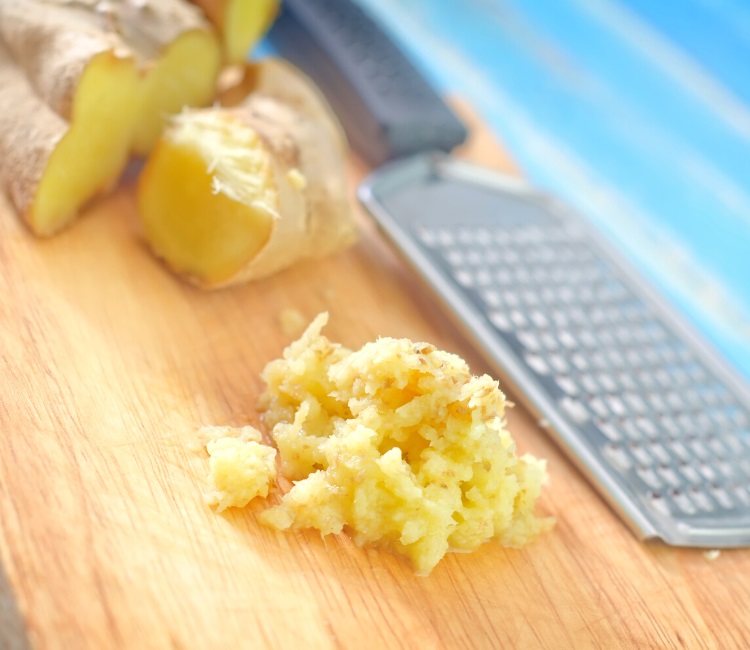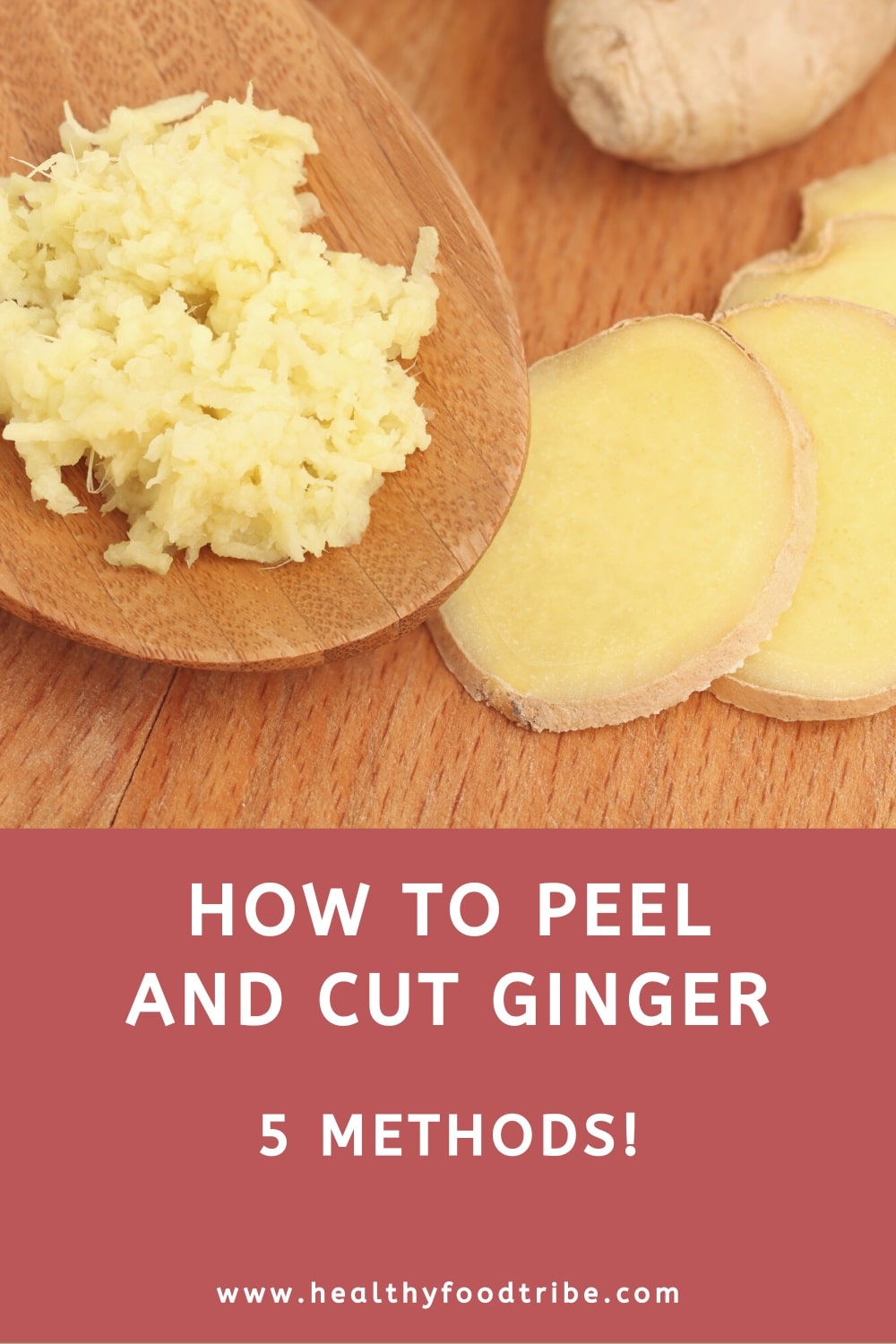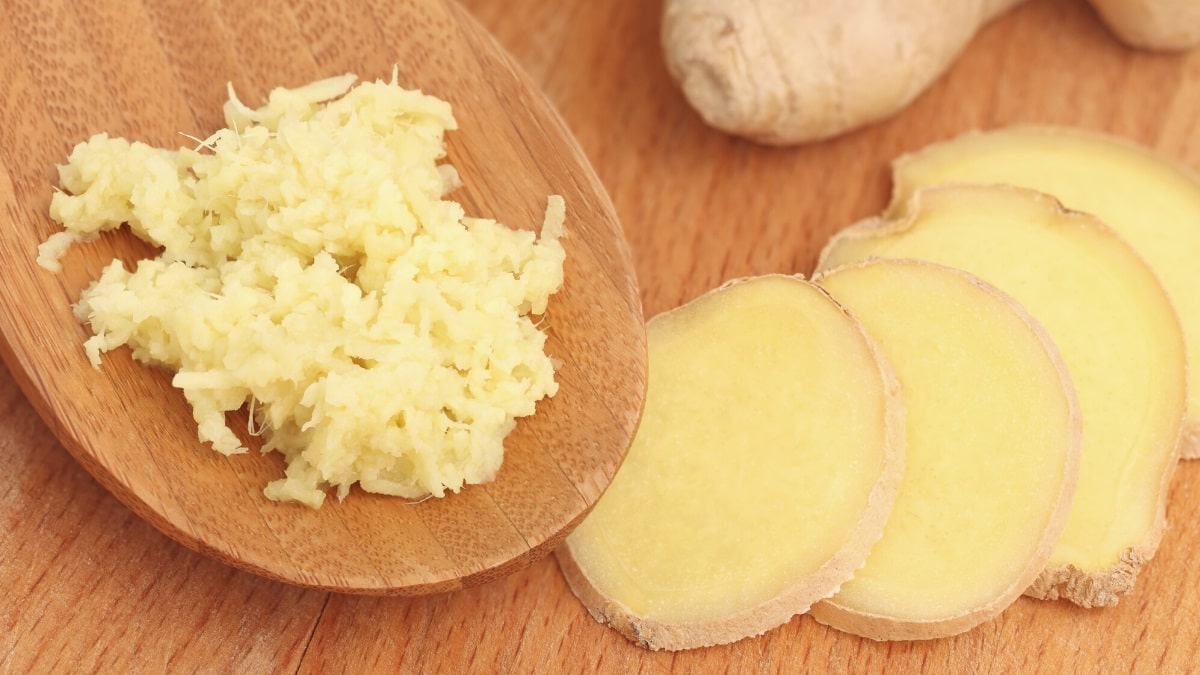Last updated: January 31, 2024
A practical guide explaining how to clean, peel, and cut ginger root for your recipes by slicing, julienning, chopping, mincing, and grating.
Ginger can be tricky to work with. That thin skin, hard flesh, and all those nooks and crannies make preparing it for any meal a bit difficult.
Luckily, a few simple kitchen tricks make cleaning and preparing this root a little easier, which ultimately comes down to practice.
Keep reading to find out how to peel and cut ginger for any meal by slicing, julienning, chopping, mincing, and grating.
Quick navigation:
Like other produce, the first step to preparing ginger is to clean it to remove any dirt, pesticide residue, and bacteria. Once it’s clean, you’ll need to peel it to remove the thin, papery skin.
Lastly, you’ll want to cut your ginger so you can use it in your recipe. This can be done in several ways, from slicing to grating. We’ll explain how to do each below.
Read my guide with storage tips to keep ginger fresh and different ways to serve and store it for later use.
Cleaning Ginger
While the ginger you get at the store will already be rinsed, it is still important to wash it yourself.
This will remove any dirt left in the crevices and bacteria that have been introduced during transport. Non-organic ginger is also likely to have chemical residue on it that should be washed away.
You can certainly do a quick clean with some water using your hands, but if you prefer a thorough clean, follow the below steps.
How to clean ginger:
- Mix 1/4 cup vinegar with 1 cup water in a clean spray bottle.
- Spray the ginger, making sure to get the cleaning mixture into the cracks and creases.
- Use a hard bristle vegetable brush to scrub the ginger.
- Rinse the ginger under cool water then pat dry.
Peeling Ginger
Peeling ginger can be a bit of a chore, especially if you have a piece with a lot of branches. Depending on what you’re going to use the cut ginger for, peeling is optional.
While using a knife to cut away the skin will work, this will also remove a lot of valuable ginger flesh. To leave as much root intact as possible, it is better to use a spoon to peel your ginger.
Using a spoon, though, requires a bit of practice and getting used to. If it’s not working for you, simply use a knife.
How to peel ginger (with spoon):
- Hold the ginger firmly in one hand with one end pressed to the counter.
- In the other, grasp the bowl part of the spoon between your thumb and bent forefinger.
- Use the edge of the spoon to scrape the skin off using firm downward pressure.
- Press the tip into the cracks and crannies to remove the skin there. Break off the branches to get in between if needed.
Pro tip:
If you’re cooking ginger, you don’t have to peel it. Ginger skin is very thin and softens as it cooks. In most dishes, you won’t be able to feel or taste the skin once the ginger has been cut and cooked with the rest of the ingredients.
Cutting Ginger
How you cut your ginger depends on the recipe you are using it for. Most will call for sliced, julienned, chopped, minced, or grated ginger.
In this section, I am going to explain, step-by-step, how to cut ginger in the following ways:
- How to slice ginger
- How to julienne ginger
- How to chop ginger
- How to mince ginger
- How to grate ginger
Let’s dive in!
1. How to Slice Ginger
Sliced ginger can be added to many savory dishes that will benefit from big bites of bold flavor. Stir fries and Asian soups often feature these larger pieces of ginger. Remember, though, that peeling is entirely optional.
Thinly sliced ginger is also great for canning and using on sushi, while thicker slices are perfect for making candied ginger. I also slice ginger root for my smoothies; for example, this carrot and spinach smoothie contains a bit of ginger.
How to slice ginger:
- Lay your ginger down so the fibers in the root are running perpendicular to your knife.
- Cut the end off to create a smooth starting surface. If there are branches or eyes, cut them off and slice them separately.
- Grip the root and slice it into pieces of your desired thickness, being careful not to cut your fingers.
- Once the ginger becomes too small to grip easily, toss the rest and start on a new piece as needed.
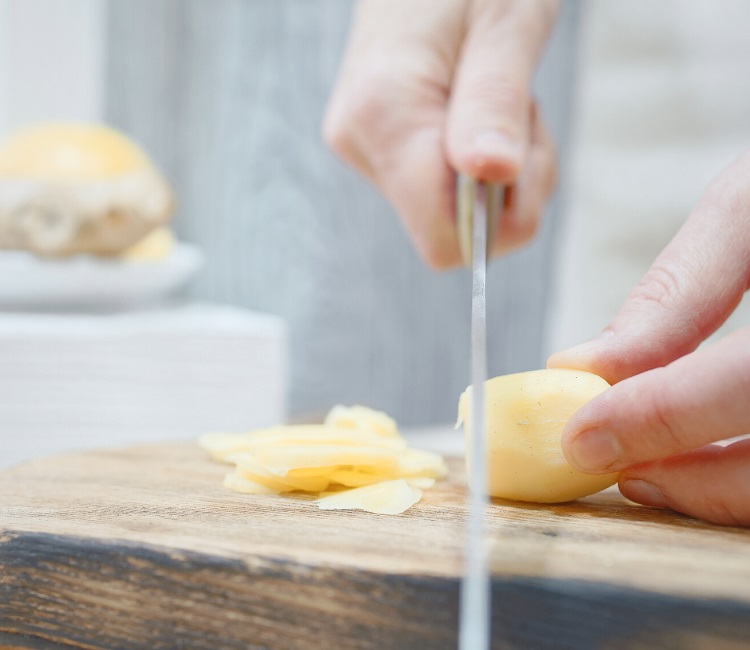
2. How to Julienne Ginger
Julienned ginger is common in recipes that benefit from a lot of bold, raw ginger flavor, but not the texture addition that large pieces bring.
Lettuce wraps, marinades, and egg rolls, often call for julienned or “matchstick” ginger. Ginger cut in this way is also great for adding to the blender for smoothies or to make broth and sauces.
How to julienne ginger:
- Lay your ginger down so the fibers in the root are running perpendicular to your knife.
- Cut the end off to create a smooth starting surface. If there are branches or eyes, cut them off and slice them separately.
- Grip the root and slice it into pieces about an eighth- to a quarter-inch thick.
- Once you have sliced all your ginger, take three slices at a time and stack them.
- Cut these slices into slivers using a downward knife motion.
- Repeat with all slices.
Pro tip:
You can use a julienne peeler on ginger. However, the fibrous nature of the root makes it tough to get a clean product. Often, a sharp knife works much better.
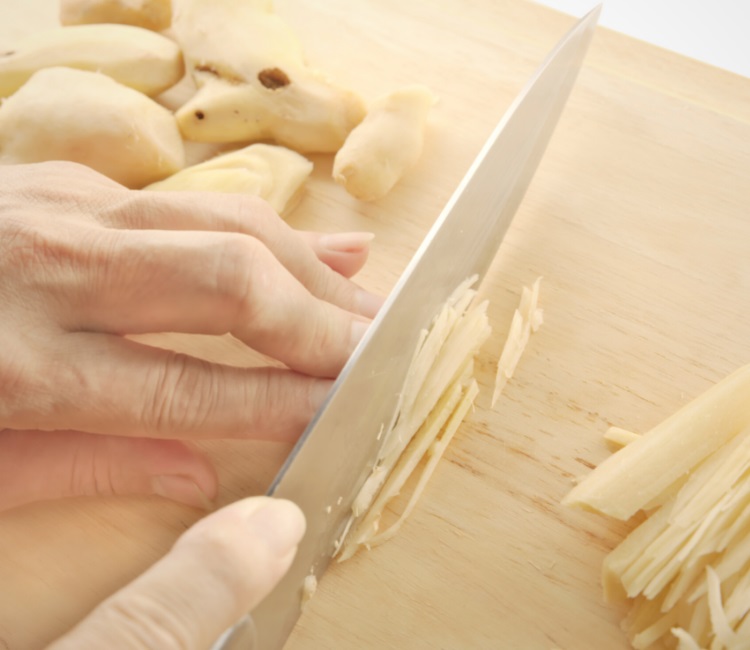
3. How to Chop Ginger
Chopped ginger is a great choice if you love the flavor of ginger but not the texture. These little pieces will infuse the recipe with tons of spicy-sweet flavor but will soften well during cooking, adding only a touch of chewy texture to the dish.
Chopped ginger goes well in many dishes, from sauteed veggies to Asian noodles. These smaller pieces also make a great addition to marinades and rubs.
How to chop ginger:
- Lay your ginger down so the fibers in the root are running perpendicular to your knife.
- Cut the end off to create a smooth starting surface. If there are branches or eyes, cut them off and slice them separately.
- Grip the root and slice it into pieces.
- Once you have sliced all your ginger, take three slices at a time and stack them.
- Cut these slices into slivers using a downward knife motion.
- Then turn the knife perpendicular to the slices and cut again to create small squares.
- Repeat with all slices.
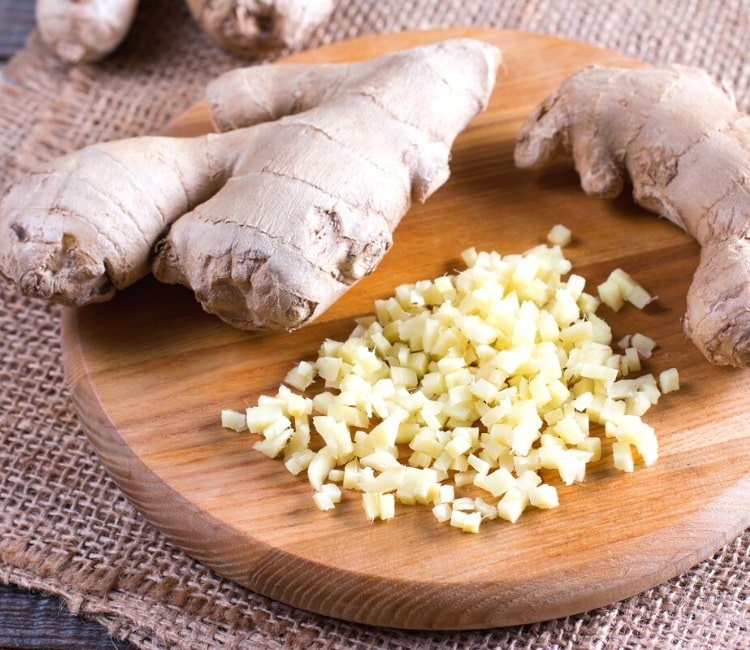
4. How to Mince Ginger
Because ginger is most often used as a fresh spice rather than a tangible ingredient in recipes, it is most commonly minced or grated.
Mincing is usually called for in dishes that need a lot of this root’s sweet, spicy flavor. Ginger cut into tiny pieces makes a good addition to sauces, marinades, sautees, curries, and many other savory recipes.
How to mince ginger:
- Lay your ginger down so the fibers in the root are running perpendicular to your knife.
- Cut the end off to create a smooth starting surface. If there are branches or eyes, cut them off and slice them separately.
- Grip the root and slice it into pieces.
- Once you have sliced all your ginger, take three slices at a time and stack them.
- Cut these slices into slivers using a downward knife motion.
- Then turn the knife perpendicular to the slices and cut again to create small squares.
- Turn your knife diagonal to the last cut and chop again.
- Repeat these diagonal cuts until the ginger is minced to your desired size.
- Repeat with all slices.
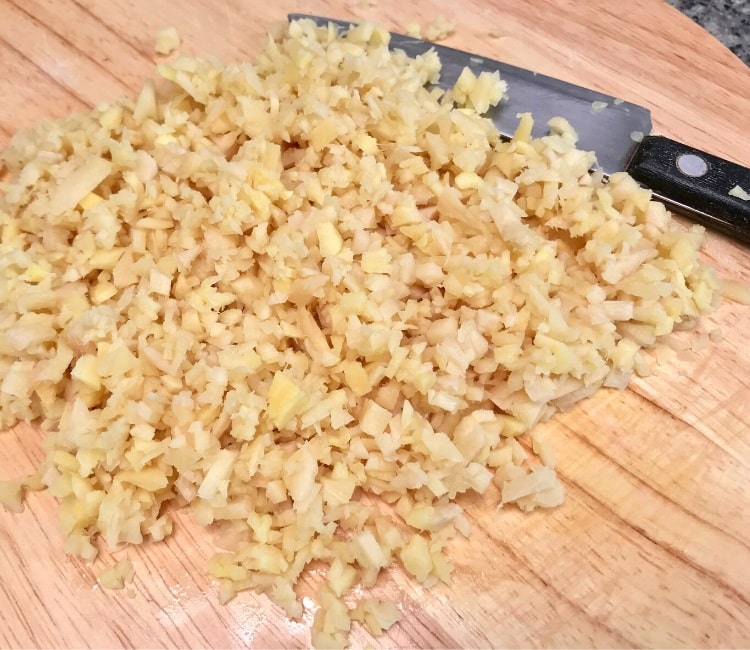
5. How to Grate Ginger
Grating ginger is one of the easiest ways to cut it, especially if your recipe only calls for a small amount.
This method is the best choice for recipes that require a smooth sauce or batter. Most desserts that feature this root call for it to be grated in order to introduce the flavor without affecting the texture of the final product.
How to grate ginger:
- Grip one end of the peeled root.
- Run the other down the sharp edge of the fine holes of your grater. Be sure to wipe down any ginger that sticks to the back of the grater as you work.
- Repeat until the desired amount of grated ginger has been created.
